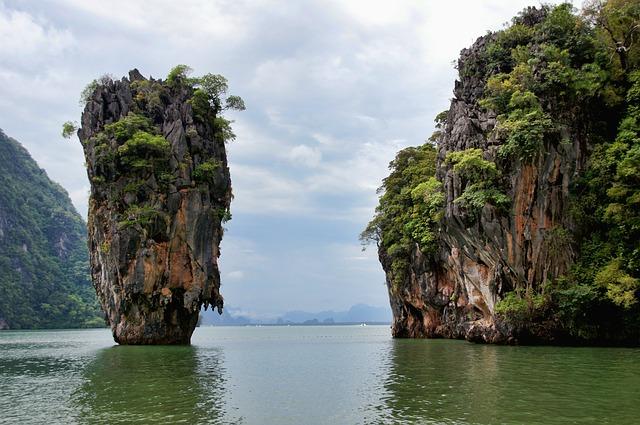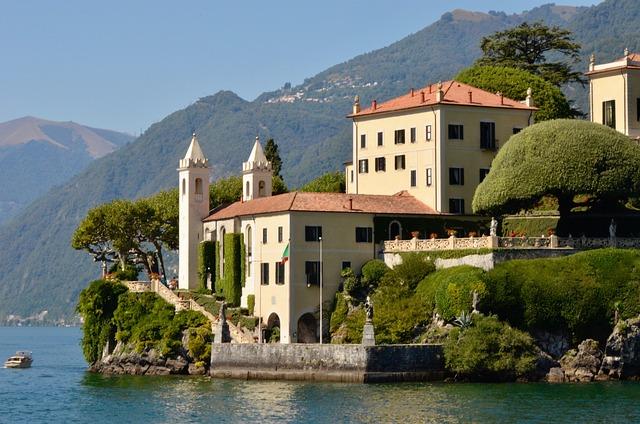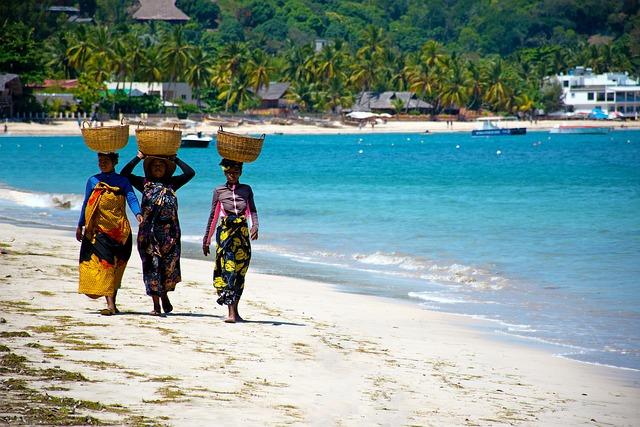Madagascar is set to make history as it prepares to issue its first blue bond, a meaningful financial instrument aimed at bolstering climate resilience and sustainable ocean management. This groundbreaking initiative comes at a crucial time for the island nation,which faces increasing threats from climate change,including rising sea levels and extreme weather events. By leveraging the blue bond mechanism, Madagascar aims to attract investment to preserve its rich marine biodiversity while promoting sustainable practices that benefit both the environment and local communities. As global attention on innovative financing solutions grows, Madagascar’s pioneering step may serve as a model for other nations grappling with similar challenges. In this article, we explore the implications of Madagascar’s blue bond initiative and its potential to transform the landscape of climate resilience funding in the region.
Madagascar’s Innovative Financial Approach to Climate Resilience
In a groundbreaking move, Madagascar is set to launch its first-ever blue bond, positioning itself as a leader in innovative financial solutions aimed at combating the impacts of climate change. This financial instrument will be directed towards sustainable ocean conservation projects, showcasing the country’s commitment to preserving its unique marine biodiversity while also enhancing resilience against environmental threats. The initiative underscores the potential of blue bonds, not only to fund conservation efforts but also to stimulate local economies through sustainable growth practices.
The anticipated funding will prioritize key areas essential for climate resilience, including:
- Restoration of mangroves: Vital for coastal protection and carbon sequestration.
- Marine protected areas: Ensuring the sustainability of fish stocks and ecosystem health.
- Community engagement: promoting local stewardship over coastal resources.
This innovative financing approach supports Madagascar’s broader climate strategy by attracting international investment while addressing local environmental challenges. By aligning monetary incentives with conservation outcomes, Madagascar hopes to serve as a model for other nations grappling with similar climate vulnerabilities.

Understanding the Mechanisms of Blue Bonds in Madagascar
Blue bonds represent a groundbreaking financial instrument designed to support ocean-related projects. in the case of Madagascar, this pioneering initiative aims to mobilize funding specifically for the enhancement of climate resilience through sustainable ocean management. The mechanisms through which thes bonds operate include:
- Capital Raising: Issued by the government or financial institutions, blue bonds enable madagascar to attract foreign and domestic investments dedicated to marine conservation and sustainable fisheries.
- Interest Rate Subsidies: To incentivize participation, investors may benefit from reduced interest rates or guarantees provided by international financial entities.
- Project Financing: Funds raised will be allocated to critical projects focused on restoring coral reefs,protecting mangroves,and improving the livelihoods of coastal communities.
The triumphant implementation of blue bonds in Madagascar hinges on meticulously structured governance frameworks, ensuring transparency and accountability in fund allocation. A proposed strategy includes establishing a dedicated oversight committee to monitor projects funded by these bonds, ensuring they meet environmental and social criteria. The anticipated impact can be summarized as follows:
| Impact Area | Expected Outcomes |
|---|---|
| Coral Reef Restoration | Increased biodiversity and fish stocks |
| Mangrove Protection | enhanced coastal protection against storms |
| Community Engagement | Improved local livelihoods through sustainable practices |

Potential Environmental and Economic Impacts of the Blue Bond Initiative
The Blue bond Initiative in Madagascar presents a unique chance to address both environmental sustainability and economic growth. By investing in marine conservation and climate adaptation, the initiative aims to protect vital biodiversity, particularly in the coral reefs and mangrove ecosystems that are essential for fisheries and local livelihoods. the potential environmental impacts are significant, including:
- Enhanced Biodiversity: Protecting marine habitats can lead to the recovery of endangered species.
- Improved Resilience: Stronger ecosystems can better withstand climate-related stresses like erosion and flooding.
- Habitat Restoration: Funds can be allocated towards restoring degraded marine environments, boosting overall health.
Economically, the Blue Bond could foster sustainable development while reducing reliance on traditional, more harmful industries. As investments flow into eco-tourism and sustainable fishing practices, local communities could see a boost in job creation. Significant economic aspects may include:
- Job Creation: Opportunities in conservation, tourism, and sustainable fisheries.
- Revenue generation: Increased tourism can lead to ample income for local economies.
- Long-term Sustainability: Economic models that prioritize ecological balance may safeguard future resources.
| Focus Area | potential Impact |
|---|---|
| Marine Conservation | Boost in marine biodiversity and health. |
| Local Employment | Enhanced job opportunities in eco-tourism and conservation. |
| Economic Stability | Diversification of income sources away from resource depletion. |

Stakeholder Engagement and Community Involvement in Climate Funding
In the journey towards establishing its first blue bond, Madagascar recognizes the importance of stakeholder engagement and community involvement in developing effective climate resilience strategies. The government plans to collaborate closely with local communities, NGOs, and private sector players to create a clear framework for funding distribution. Successful implementation hinges on a participatory approach that empowers local voices, ensuring that the interests and knowledge of those most impacted by climate change are integral to decision-making processes. By leveraging local expertise, Madagascar aims to build customized solutions that reflect the unique socio-economic and environmental contexts of its diverse communities.
to facilitate this engagement, Madagascar’s approach includes an array of activities designed to foster collaboration and knowledge exchange. Key initiatives will involve:
- Community Workshops: Organizing local forums to discuss climate vulnerabilities and potential adaptation strategies.
- Training Programs: Providing educational resources for local stakeholders on sustainable practices and financial literacy related to climate funding.
- Feedback Mechanisms: Establishing channels for ongoing community input to refine climate projects and ensure they meet local needs.
In addition, a structured partnership with international organizations will help in capacity building and knowledge transfer, further enhancing Madagascar’s institutional framework. The table below summarizes the key stakeholders involved in the blue bond initiative:
| Stakeholder | Role |
|---|---|
| Government Agencies | Policy formulation and fund allocation. |
| Local communities | Participation in decision-making and project implementation. |
| NGOs | Facilitating outreach and community engagement initiatives. |
| Private Sector | Investment and innovation in sustainable practices. |

Strategies for Effective Implementation and Monitoring of Blue Bond projects
For successful execution of blue bond projects,it is crucial to establish a thorough framework that guides their planning and deployment. Key strategies can include:
- Stakeholder Engagement: Involving local communities, NGOs, and governmental bodies from the outset to foster a sense of ownership and accountability.
- Risk Assessment: Conducting thorough analysis to identify potential environmental and social risks and developing mitigation strategies.
- Capacity Building: Investing in training programs for local staff and community members to enhance their skills in project management and marine resource conservation.
Monitoring and evaluation play a vital role in ensuring the long-term success of blue bond initiatives. Implementing a robust framework that includes
- Performance Indicators: Establishing clear metrics for success related to ecological impact, community engagement, and financial sustainability.
- Regular Reporting: Creating a structured schedule for progress reporting that promotes transparency and accountability to stakeholders.
- Adaptive Management: Allowing flexibility in project operations to make necessary adjustments based on ongoing feedback and data analysis.

Lessons from Global Blue Bond Experiences: Best Practices for Madagascar
Madagascar’s journey into blue bond issuance can greatly benefit from the experiences of countries that have successfully navigated similar paths. Key lessons learned demonstrate the importance of stakeholder engagement and collaboration among various sectors. A transparent and inclusive approach can help secure the necessary investments and ensure the projects are aligned with community needs. Malagasy officials should focus on building partnerships with local fishing communities, environmental NGOs, and international investors to foster shared ownership and accountability in the development of marine conservation projects.Additionally, leveraging technology for data collection and ecosystem monitoring can enhance decision-making processes and demonstrate the tangible benefits of blue bonds.
Another critical aspect to consider is the design of a robust framework for measuring and reporting outcomes. Establishing clear metrics that highlight both environmental and social impacts can attract potential investors and build trust among stakeholders.Best practices from other nations suggest the implementation of an adaptive management framework, allowing for continuous enhancement and adjustment based on results. This could involve:
- Regular impact assessments to track progress towards marine sustainability goals.
- Transparent financial reporting to provide insights into fund allocation and project viability.
- Community feedback mechanisms to incorporate local knowledge and preferences into project development.
| Focus Area | best practice |
|---|---|
| Stakeholder Engagement | Involve local communities in project design and implementation |
| Impact Measurement | Develop clear metrics and frameworks for tracking success |
| adaptive Management | implement flexible approaches to respond to new challenges |

To Conclude
As Madagascar stands on the brink of launching its first blue bond, a significant step towards bolstering climate resilience and sustainable development, the implications extend far beyond its shores. This pioneering financial instrument not only aims to safeguard the island’s rich marine ecosystems but also sets a precedent for other nations grappling with the urgent challenges posed by climate change. By investing in nature-based solutions, Madagascar is signaling a commitment to preserving its unique biodiversity while fostering economic growth. As global attention turns to the increasingly urgent need for innovative financing mechanisms to address environmental crises, Madagascar’s initiative may serve as a model for sustainable development in the blue economy. The world will be watching closely as Madagascar embarks on this ambitious journey, hoping to inspire similar efforts in vulnerable regions worldwide.







